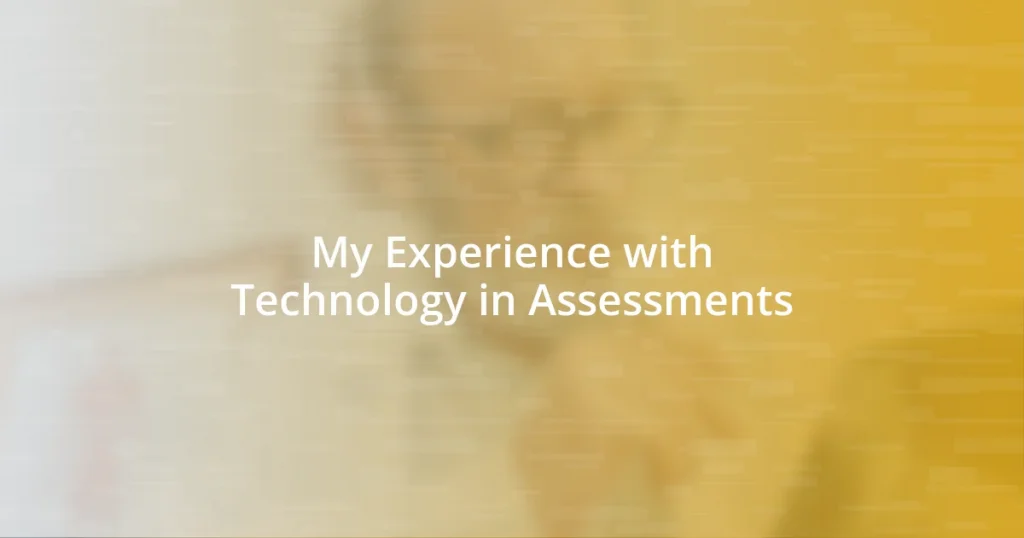Key takeaways:
- The shift to technology in assessments has enhanced student engagement and personalized learning experiences through instant feedback and diverse tools.
- While technology in education offers significant benefits, challenges such as the digital divide, learning curves, and data privacy concerns must be addressed.
- The future of assessments may leverage AI, blockchain, and VR/AR technologies to create personalized, secure, and engaging learning experiences for students.

Introduction to Technology in Assessments
As I reflect on my experiences with technology in assessments, I can’t help but think about how transformative these tools can be. The shift from traditional paper-based evaluations to digital platforms has not only changed the way we assess knowledge but has also created a more engaging environment for learners. Has anyone else felt the thrill of instant feedback during a digital quiz? That immediate response can be both enlightening and motivating.
During my early days in education, I vividly remember the anxiety of waiting for results after a big exam. Fast forward to today, and technology has streamlined this process significantly. With just a few clicks, educators can analyze performance trends and tailor their teaching strategies effectively. This adaptability not only enhances assessment accuracy but also fosters a more personalized learning experience for students.
Moreover, I’ve seen firsthand how online assessment tools can bridge gaps for diverse learners. For instance, one student in my class struggled with traditional tests but excelled in interactive online scenarios that catered to his unique learning style. Isn’t it fascinating how technology can empower individuals, offering them a chance to shine when traditional methods might otherwise hold them back?

Importance of Technology in Education
The role of technology in education is crucial. It not only modernizes the learning process but also enhances student engagement. I remember once using an interactive app during a review session. The excitement in the classroom was palpable as students actively participated instead of passively listening. That moment reinforced my belief that technology can transform learning into an interactive and enjoyable experience.
Here are several key points to consider when thinking about the importance of technology in education:
- Access to Resources: Students can access a wealth of information beyond textbooks, broadening their understanding.
- Customized Learning: Technology allows for personalized learning experiences, catering to individual student needs and paces.
- Collaboration and Communication: Online platforms foster collaboration among students, creating a sense of community and shared learning.
- Continuous Feedback: Real-time assessments provide immediate feedback, helping students track their progress and improve swiftly.
- Preparation for the Future: Familiarity with technology prepares students for the digital workforce, equipping them with essential skills for their careers.

Tools for Digital Assessments
When it comes to tools for digital assessments, I’ve discovered a wide variety of platforms, each with its strengths. For example, I’ve used Google Forms for quick quizzes; it’s simple to set up and allows automatic grading. However, I found that platforms like Kahoot! really elevated the experience by incorporating game-like elements, turning assessments into a fun competition that keeps students engaged. Have you noticed how excitement can change the atmosphere in a classroom?
Another tool I’ve come across is Microsoft Teams, which integrates assessment features seamlessly into a collaborative environment. I recall a time when my students were able to complete peer assessments in real-time during a project. It was eye-opening to witness how technology not only facilitated learning but also taught students how to give constructive feedback. It made me realize the importance of collaboration skills in modern education.
Below is a comparison of some popular digital assessment tools that I’ve encountered, showcasing key features that might help your decision-making process:
| Tool | Key Features |
|---|---|
| Google Forms | Easy to use, automatic grading, and data visualization. |
| Kahoot! | Game-based learning, engaging quizzes, and live feedback. |
| Microsoft Teams | Collaboration features, integrated assessments, and peer feedback options. |
| Quizizz | Self-paced quizzes, leaderboard features, and detailed insights. |

Benefits of Using Technology
The benefits of using technology in assessments are truly remarkable. For instance, when I implemented online quizzes, I quickly noticed a significant improvement in student participation. It was almost like flipping a switch; their engagement skyrocketed, and I could see them in their element, ready to tackle challenges in a way that traditional methods never achieved.
One specific moment stands out. I introduced a platform that allowed for instant feedback, and the students’ faces lit up as they saw their scores flash in real-time. This immediate response sparked discussions about their approaches and mistakes. I can’t emphasize enough how empowering it was for them to take charge of their own learning through technology—don’t you think that’s a game-changer?
Furthermore, I believe technology fosters a deeper connection among students. During group assessments on digital platforms, I observed friendships bloom as students collaborated to solve problems. They encouraged each other, shared resources, and built a sense of community that transcended the classroom walls. Isn’t it wonderful to think that technology, in all its forms, can not only enhance learning but also strengthen our bonds as educators and learners?

Challenges in Implementing Technology
Encountering challenges when implementing technology in assessments is a reality I’ve faced numerous times. One significant obstacle is the digital divide. I remember a project where a portion of my students struggled to access the necessary devices or reliable internet at home. It was disheartening to see eager learners sidelined simply due to technology limitations. Have you ever felt that frustration in your own experiences?
Another issue arises from the learning curve associated with various platforms. I can vividly recall my initial struggle when transitioning to a new assessment tool that promised innovative features. The steep learning curve not only frustrated me but also made some students hesitant to engage with the technology. Thus, it’s crucial to provide adequate training and support; otherwise, the technology meant to enhance learning can become a barrier.
Security and privacy concerns can also weigh heavily on educators’ minds. When I first started using online assessments, I was struck by the need for robust data protection measures. I found myself questioning how student data would be handled and who could access it. This made me pause and reflect on my responsibilities as an educator in protecting my students’ information. How do we strike a balance between leveraging technology and ensuring our students’ safety?

Personal Insights and Experiences
I’ve had my fair share of transformative moments while using technology in assessments. One time, I set up a virtual escape room for a group project. Watching the excitement on my students’ faces as they deciphered puzzles together reminded me of why I love teaching. It wasn’t just about the content; it was about sparking joy and collaboration through a tech-driven experience. Have you ever witnessed a dynamic like that in your own work?
On the flip side, I’ve also dealt with unexpected hiccups. There was a time when I planned a live online test, only to be thwarted by a sudden internet outage. I could see the panic in my students’ eyes, which almost mirrored my own. It was a tough lesson in flexibility. How do we prepare our students for the unpredictable nature of technology, while still maintaining a sense of calm? For me, this experience reinforced the need to have backup plans and to teach resilience along with academics.
Feeling overwhelmed can also be part of the experience. I distinctly remember when I first integrated analytics to assess student performance. The sheer volume of data was intimidating. However, as I gradually learned to navigate this wealth of information, I found that it empowered me to tailor my teaching strategies to better serve my students. Isn’t it fascinating how challenges can often lead to growth if we’re willing to embrace them?

Future of Technology in Assessments
As I look ahead at the future of technology in assessments, I can’t help but feel a mix of excitement and cautious optimism. Picture this: AI-powered adaptive assessments that adjust in real-time based on student performance. I envision a world where each learner receives a personalized experience tailored to their strengths and weaknesses. Isn’t it empowering to think that technology could adapt in such a nuanced way, reflecting the unique learning journey of each student?
Moreover, I’ve been reflecting on blockchain technology and its potential for securely verifying credentials and achievements. This could transform the landscape of academic integrity, as I imagine it would provide a transparent record of student accomplishments. It’s almost thrilling to think that we could eliminate the worries we face today regarding authenticity. What if our students could complete assessments knowing their efforts are securely validated forever?
I also see virtual reality (VR) and augmented reality (AR) playing crucial roles in assessments. I remember experimenting with some basic VR tools in the classroom, and it opened up an entirely new realm of engagement. Imagine students walking through historical events or simulating scientific experiments—all while being assessed on their knowledge! Wouldn’t that revolutionize not only assessments but the entire educational experience? The possibilities are vast, and I believe the right integration of these technologies will lead to deeper, more meaningful learning adventures.















